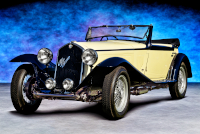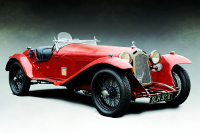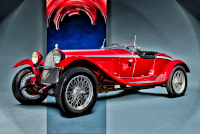Location:
St. Michaels Concours d'Elegance, 2021
Owner: Bruce Vanyo | Greenwich, Connecticut
Prologue:
After a year weathering the pandemic, a sun-filled day at St. Michaels brought a beautiful return to form. Gone, the hectic crowds of Radnor Hunt earlier in the month, where we stopped to spot Bugatti almost exclusively. Better spirits here, beautiful day.
First on the menu, this 6C 1750 Gran Sport Castagna. And I feel confident in the light. Using on-location photographs, one must decide whether to preserve the light quality in the final product. A grey cast more easily neutralizes reality within a graphic design aesthetic. But for a day such as this, the sun-glow remains.
I like how the feeling of a single day can be preserved even through heavy illustration; it is the original light quality, the rays that create glow and reflections in the metal. So instead of trying to cloak the original light source, I juiced it. In this case, I want to be creative without lying about the process. You do not need to believe the car sits in a studio, but instead consider the illustration part of the car's reality, perhaps like a scene from a Merchant-Ivory film.
Chassis #121215037 also tricked me for a spell. I had not realized, but the Bonhams auction catalogue from their 2008 Quail Lodge sat on my bookshelf, identification source for this same 6C 1750. Except at the time, the car had been painted red and wore a completely different set of skirted running gear. However, we've put the pieces together and draped enough context over the design. Castagna give the 6C chassis luxury pretentions, which reminds us that, for as many sporting Alfa Romeo cars as travelled to the US, a great number of touring versions remained on the continent.
- - - - - - - - - -
► Image Source: Nikon D750 (24.3 MP)
References:
- Automobile Quarterly, Volume 7, Number 2, "Alfa Romeo 6C 1750" by Michael Lorrimer, The Kutztown Publishing Company, Inc., Kutztown, PA, page 200
- d'Amico, Stefano. "Pure Alfa Romeo" Libri Illustrati Rizzoli, Milano, Italia, 2017, page 64
- Quail Lodge, A Sale of Exceptional Motorcars and Automobilia, Friday August 15, 2008. Bonhams & Butterfields. San Francisco, CA. 2008, page 204-207. As the car changed stripes since 2008, I sat flumoxed for some while over which chassis this is, not realizing that I own the Bonham's auction catalogue that includes the print profile. See also the Bonhams online entry below.
- Hamann Classic Cars: A recent account of the chassis #121215037, with complete owner history.
- Bonhams: Chassis #121215037 sold in 2008 as finished in Australia, red with its original running gear.
- Bonhams: Chassis #8513078 displays beautiful coachwork unlike most Castagna-bodied 6C 1750 cars.
Summarized as small-scale luxury, comparisons to Isotta-Fraschini and Lancia matter in terms of using Alfa Romeo mechanicals for touring as opposed to sport. This role is not unusual for Alfa Romeo, though off-hand the touring-inspired vintage Alfa seems more prevalent in Europe than the United States, where enthusiasts tend to import race-bred examples. But these touring cars became prevalent in the first place precisely because the 6C 1750 has, by 1933, served its competitive purpose. Alfa are about to transition to the 6C 1900, to say nothing of the capability the new 8C demonstrates. These 6th series cars, the last of the 6C models, are therefore more refined, expected to take on the road more than rally.
The car depicted here, chassis #121215037 has in fact toured the world. Originally sold to an Englishman, next exported to Australia in 1975, transferred to Brazil in 1997, and eventually sent to California in 2008, the car crossed North America and landed in our sights in 2021. The original owner kept the car for over 40 years, during which time he stored the Alfa, which of course led to a barn-find resurrection in the late 1950s. Complete and relatively straight, the Alfa received its first full restoration during its stay in Australia, circa 1986. That restoration replaced the original cream and black livery with conventional red paint. The car wore its original running gear at the time, appearing more typical of Castagna designs, with skirted fenders and an integrated tool box.
The car's second restoration, completed not very long ago and fairly close by at D.L. George Historic Motorcars, altered the running gear. Hamann Classic Cars notes, "During the restoration, David L. George fitted this Alfa Romeo with new wings in the style of the elegant Castagna bodied 8C Alfa Romeo. The original wings have been preserved and refinished to match the car and could be easily put back on the car as the mounting brackets remain unaltered." Though changing the car's fundamental attitude, George repainted that car in its original livery. My illustrations quite deliberately heighten the sky blue reflections; the car is otherwise French cream on the body with antique black accents.
Motor: 1,752 cc straight 6-cylinder, cast iron block, alloy hemi-head | 65 mm x 88 mm | 5.0:1 compression | #121215037
The motor is the correct, matching block complete with its original steering box. As a true 6th series 1750, the motor should be fitted with an alloy head.
Valvetrain: DOHC, 2 valves per cylinder
Aspiration: dual-choke carburetor, Roots-type supercharger
Typically a Memini DOA carburetor, Bonhams notes that a previous owner replaced the original, along with oil and water pumps.
Power: 85 bhp @ 4,500 rpm
Drivetrain: 4-speed gearbox, rear-wheel drive
The gearbox (#101025000) is not original to the car, but period-correct. The 6th series adds synchromesh on third and fourth gears, as well as a freewheel mechanism, very much a concession to roadability.
Front Suspension: beam axle, semi-elliptic leaf springs, friction dampers
Rear Suspension: live axle, semi-elliptic leaf springs, friction dampers
Architecture: pressed steel ladder-frame chassis with box section and body by Carrozzeria Castagna of Milan
Kerb Weight: 1,000 kg (2,205 lbs)
Wheelbase: 2,920 mm (115 inches)
Etymology:
'6C 1750' refers to the motor configuration, a straight 6-cylinder of about 1.75 litre displacement. 'Gran Sport' refers to the fourth series update of Alfa Romeo's Super Sport platform, with the notable addition of a roots supercharger. The term 'cabriolet' differs from the 'spider' in fit and finish, more appropriate for touring than road racing. Carrozzeria Castagna, the Milanese coachbuilder, provides the bodywork.
Figures:
From 1929 to 1933, Alfa Romeo built a reported 2,579 examples of the 6C 1750, doing so in six different configurations over four successive development series. In truth, the 6C is a model split across the 6C 1500 (Series 1 and 2), and the 6C 1750 (Series 3 through 6). These figures make the 6C 1750 a volume production sports car at a time when the thing itself does not exist. Of the total production figure, Alfa Romeo built 257 Gran Sport Spiders, all from 1930 to 1933. Zagato most often provided the coachwork.
Chassis #121215037 is one of approximately 44 6th series Gran Sport cars, only two of which are Castagna-bodied.
Grand Touring: Alfa Romeo Counterpoint to Isotta Fraschini and Lancia
Not so similar to the Castagna-bodied 8C 2300 Mille Miglia—a Simeone Foundation car, and something of a hot rod oddity—Castagna-bodied Alfas are better representive of grand touring coachwork. The Milanese builder clothed the finest contemporary Isotta Fraschini and Lancia cars, top-market luxury exercises replicated on a smaller scale with this 6-cylinder Alfa Romeo chassis. A substantial windscreen configuration, running gear, body moulding, and proper hood provide stateliness in place of Alfa's typically sporting demeanor. Inside, wood replaces brushed aluminum, layering refinement over the controls. With its supercharged, dual-overhead cam motor, this 6C eclipses most automobiles of the day in terms of accessible, roadable performance, just not to the extent of its lighter Zagato-bodied kin.
Castagna Design: Common Attributes of the 6C Cabriolet
Glossing similar examples, a few common attributes include the basic tail shaping, bonnet and footwell louvres, and thick moulding along the shoulders. The body moulding includes a single scallop beneath the windscreen edge, and another above the continental kit. The rear fenders integrate with the tail nicely, exhibiting a tapered effect better realized in those cars carrying only a single spare, whereas dual spares tip the balance toward the rear.
Of the running gear, Castagna originally bodied #121215037 with skirted fenders. The simple, unskirted running gear shown on this example is a late fabrication by D.L. George Historic Motorcars, who also restored the original kit. The alteration helps the car retain a light, upright stature, not quite as refined (or so we might believe) as those with skirted fenders, though the lines of most are roughly the same.
Similar Citations: A Note on the Few Known 6C Castagna Cabriolet Examples
We find citations for chassis #121215037 as it appeared following its Australian restoration in 1986, complete with original running gear, though temporarily painted red. Another example is a personal favorite, chassis #8513078 from 1930, which wears coachwork completed by Castagna in 1935. Chassis #8513078 appears in Stefano d'Amico's Pure Alfa Romeo, demonstrating an elegant turn of line and consideration to posture and prettiness befitting the short chassis 6C Alfa.
Last Updated: Mar 26, 2025
















